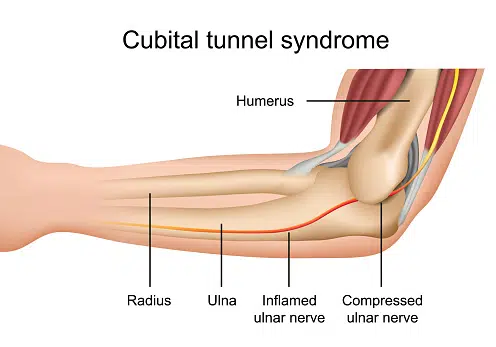Ulnar nerve entrapment is also known as Cubital tunnel syndrome. The ulnar nerve is a part of the brachial plexus, which is a group of nerves that connect to the spinal cord and send signals to and from muscles in the arms and hands. The ulnar nerve branches off the brachial plexus at the shoulder and travels down the back of the arm to end in muscles in the forearm and hand. The ulnar nerve transmits electrical signals to those muscles. It also transmits sensation from parts of the hand and underside of the forearm. Ulnar nerve entrapment occurs when this nerve becomes compressed or stretched out in its path through an area such as a tunnel or tendon sheath. This can cause pain, numbness and tingling in these areas. In severe cases, ulnar nerve entrapment can cause weakness in your hand and loss of muscle mass
Diagnosis
After a detailed history and physical exam, your doctor may order additional tests, including electromyography (EMG) and nerve conduction study (NCS), to evaluate how the muscles and nerves are functioning. An EMG measures ongoing muscle activity and response of the muscle to its nerve stimulation. An NCS measures the amount and speed of conduction of an electrical impulse through a nerve.
An electromyogram (EMG) is a test that detects electrical activity produced by muscles. An EMG can help doctors diagnose motor neuron diseases. It can also be used to monitor recovery from spinal cord injuries or other disorders that affect muscle function.
In an EMG test, small needles are inserted into specific muscles or areas around them. The needles record the electrical activity generated by these muscles when they contract or relax. The results of this test allow doctors to determine whether there is any damage to the nerves supplying those muscles.

Causes
Ulnar nerve entrapment can occur at the elbow and wrist, and this condition can result in tingling and numbness in the hand.
Ulnar nerve entrapment at the elbow can occur when there is prolonged stretching of the nerve by keeping the elbow fully bent or when there is direct pressure on the nerve from leaning the elbow against a solid surface. Entrapment at the wrist can occur when there is direct pressure on the nerve by leaning on handlebars during long bike rides or prolonged use of hand tools. Similar to the phenomenon of a person’s arm “going to sleep,” or “hitting your funny bone,” a pinched ulnar nerve can result in tingling, pain and numbness.
In some people, the ulnar nerve does not stay in its proper position and can shift across a bump of bone in the elbow when the arm flexes, referred to as a subluxing nerve. Repeated shifting can cause irritation of the ulnar nerve.
Treatment
Nonsurgical treatment for ulnar nerve entrapment:
If a person has ulnar nerve entrapment, the physician may recommend that they follow a number of different treatments.
Depending on how severe the entrapment is, the physician may recommend occupational therapy to strengthen the ligaments and tendons in the hands and elbows. If the condition isn’t too severe, he or she may also recommend drugs such as aspirin, ibuprofen and other nonprescription pain relievers to help reduce pain and inflammation.
Finally, he or she may recommend splints to help immobilize the elbow.
Surgical treatment for ulnar nerve entrapment:
If you’re experiencing persistent pain in your elbow or hand, it could be due to compression of the ulnar nerve. There are two types of ulnar nerve release surgery that can help address this issue:
- At the elbow
The surgeon makes an incision at the patient’s elbow and performs a nerve decompression, and in some instances, moves the nerve to the inner part of the arm so that it is in a more direct position.
- At the wrist
If the compression is at the wrist, the surgeon makes the incision there to access the ulnar nerve and performs the decompression at that location.
Recovery from Ulnar Nerve Entrapment Surgery:
The healing process after surgery can be a little different for everyone, but you can generally expect to be able to remove your bandages within 24 hours and have stitches taken out in about 10 days. After that, it may take four to six weeks before you’re back to your normal routine.